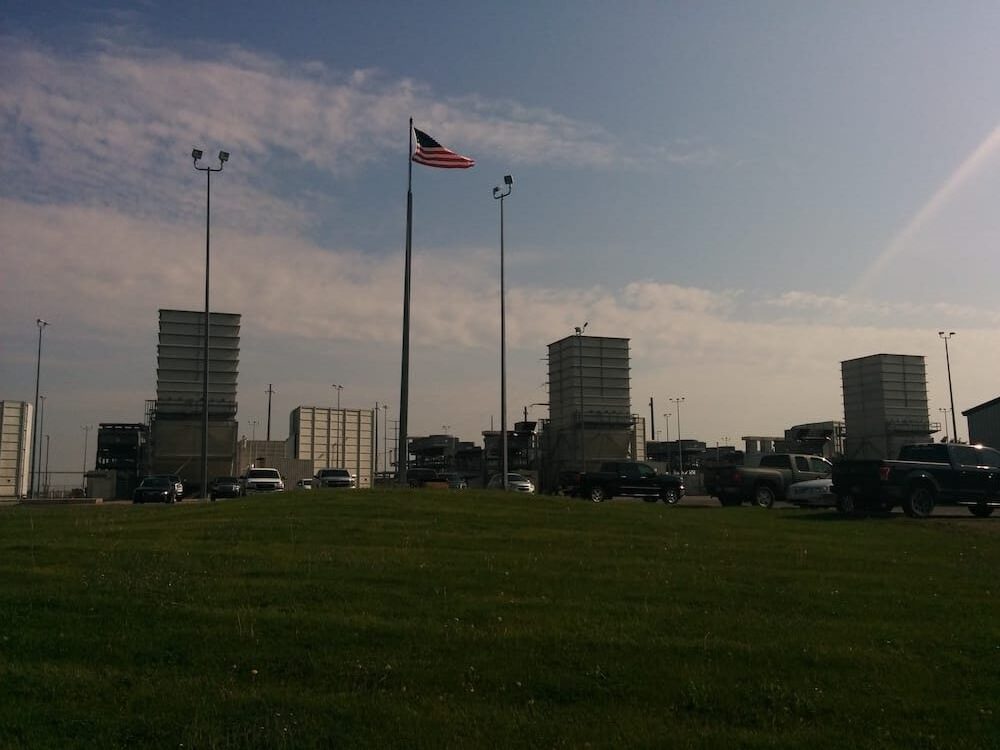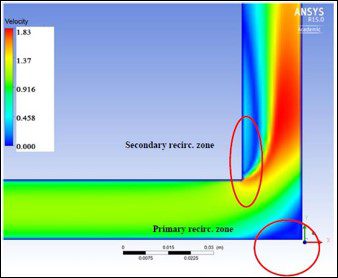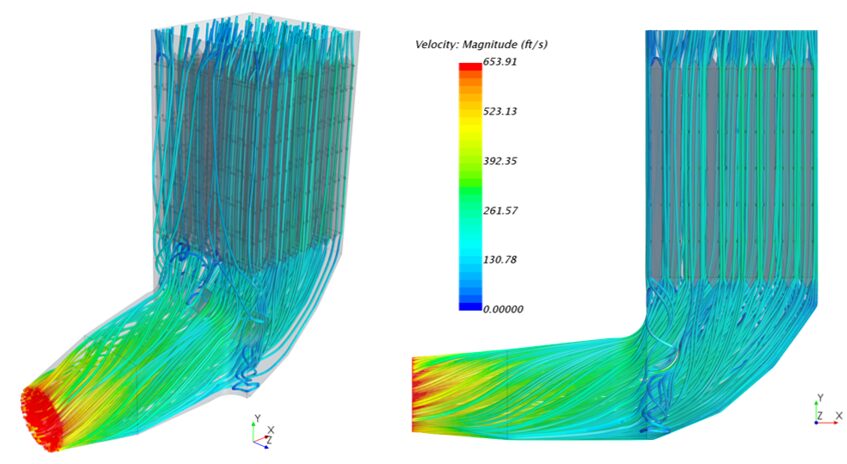
Written by Brad Buecker | Technical
For the many combustion turbines that provide power around the country, the focus is often on the gas turbine, as it and the generator are the core components of the unit. However, also important is consistent performance of the air intake and exhaust gas outlet systems. This article focuses on exhaust gas issues and how computer aided engineering (CAE) and outlet duct modifications derived from CAE data can improve gas turbine performance and efficiency.

Exhaust System Issues
The following list outlines important items that CAE evaluations, acoustic analyses, thermographic readings, and visual inspections can provide in identifying deficiencies with existing exhaust systems and for making the correct modifications.
- Optimize flow distribution from the turbine exhaust through turning vanes, silencer baffles, and the stack exit to minimize vibration, reduce eddy currents and other flow anomalies, attenuate noise, and improve temperature uniformity within the duct.
- Reduce noise by baffle/silencer and duct liner improvements.
- Reduce exhaust gas pressure drop, which increases turbine efficiency
- Find weak spots in duct lining.
As a foundation for discussion of the first bullet item, consider Figure 2 below, the schematic of a geometrically simple exhaust duct evaluated in wind tunnel tests.

Two primary items stand out in this model. One is the absence of flow at the far corner of the duct transition from horizontal to vertical configuration. (As the reader may have already observed in Figure 1, the ducts at this plant have curved elbows in place of the sharp corners.)
Second is maldistribution of flow at the near corner of the duct. The geometry can produce eddies and circular flow patterns along the near wall, with excessive flow at the far wall. These influences in turn can induce mechanical and thermal stress in localized locations.
Accordingly, most exhaust ducts are equipped with internal turning vanes to guide the exhaust gas around the corner. Important is properly calculating turning vane size, orientation, and location.
Another item regarding exhaust system design is noise attenuation. At an SVI project on which some of this article is based, a school, retirement village, and residential homes are located within a half a mile of the plant. Because combustion turbines in large measure represent stationary jet engines, noise control is obviously critical. Typical in the upper sections of the vertical portion of the duct are baffles or silencers for noise abatement. The silencers may have a variety of designs, including long, parallel baffles, concentric baffles, or staggered variations. Materials may include basalt, mineral wool, or ceramic fiber, with supporting structures of steel.
The silencers are obviously needed to reduce the noise of what would sound like a screaming jet engine, but other phenomena, such as vibration, within the duct can produce many sounds, including low-frequency noise. These sounds may not be audible to plant staff and citizens near the facility, but they can cause continuous nuisance vibrations in homes and buildings. Silencer design and modeling needs to account for these low-level sounds as well. A mitigating aid for low-level sound control is both internal and external duct lining. Internal linings are typically thin and of a material that can withstand the harsh environment, while external linings may be six inches thick and more closely resemble insulation.
So, from what has been presented so far, it is apparent that design of exhaust duct internal components can be quite complex. What methods are available to provide accurate data?
CAE to the Rescue
The CAE program employed by SVI personnel utilizes computational fluid dynamics (CFD), boundary element method (BEM), and acoustic modeling techniques. Per the development of high-powered computers, CFD and BEM modeling have become mature technologies that can incorporate virtually all details of exhaust duct design, including internal component size, location, and orientation, to produce optimized arrangements. Figure 3 shows the simplified outline of one such model.

Clearly obvious in this diagram is the uniform gas flow. Note also the rounded corners in the horizontal-to-vertical transition zone.
An effect that such modeling, and subsequent physical improvements to duct internals, can have on gas flow is reduced pressure drop through the exhaust system by perhaps as much as 2” H2O. This in turn improves the turbine efficiency, maybe only by a small amount but still beneficial.
In conjunction with CFD and BEM modeling, SVI personnel also perform before and after acoustic modeling both at the plant (near-field) and in surrounding neighborhoods (far-field). The modeling includes low-level noise measurements, as mentioned above. These evaluations will reveal the need for additional noise attenuation and the effects of system modifications on noise output. Plant personnel may perhaps be able to generate some good will if they can inform citizens within the vicinity of the plant that noise levels have been lowered.
An added feature of an SVI inspection and audit of existing systems is thermographic analysis of the duct. The technique identifies excessive heat loss locations, which can then be corrected by installation of lining or lagging during a suitable outage period.
Discharge of the exhaust gas from a combustion turbine is a much more complicated process than one might first imagine. Many details go into design and orientation of internal components to protect the system and to stay within the boundaries of plant noise limits. Often, original designs are lacking in this regard. SVI Industrial personnel have extensive experience with exhaust gas flow modeling and making the physical modifications to optimize performance. Contact them for help on projects like this.
